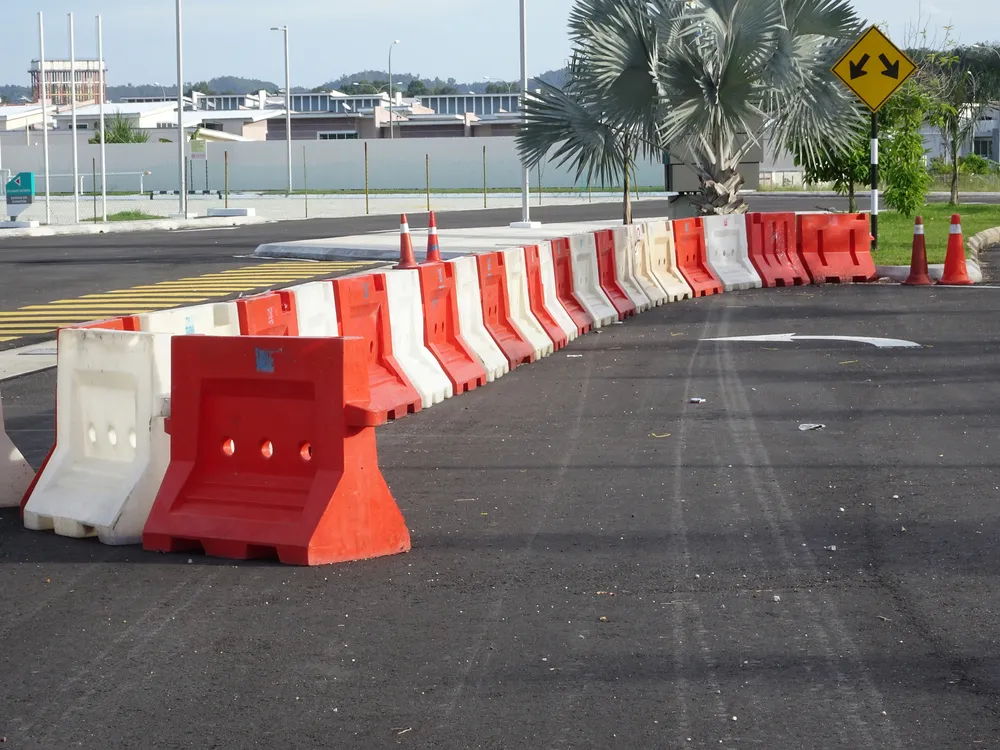When driving along highways and urban roads, you’ve likely noticed sturdy concrete barriers lining the road. These are Jersey barriers, essential structures that play a crucial role in traffic management and safety. Introduced in the 1950s, these barriers are designed to minimize vehicle damage and prevent crossovers, reducing the risk of head-on collisions. In this article, we’ll explore what Jersey barrier are, their design and functions, and their various applications.
What is a Jersey Barrier?
A Jersey barrier is a modular concrete or plastic barrier used to separate lanes of traffic. Initially developed in New Jersey (hence the name), these barriers are designed to prevent vehicles from crossing into oncoming traffic lanes, thereby reducing the likelihood of severe collisions.
Design and Structure
Jersey barriers are typically 32 inches high and have a sloped design that redirects vehicles back onto the roadway upon impact. This sloped design helps to absorb and reduce the impact force, minimizing damage to vehicles and protecting passengers. Some modern versions are taller, blocking oncoming headlights and improving safety during nighttime driving.
The Evolution of the Jersey Barrier
Historical Development
The concept of the Jersey barrier dates back to the 1950s when engineers sought a solution to reduce crossover accidents on busy highways. The initial designs were simple concrete blocks, but over time, the barriers were refined to improve their effectiveness and durability.
Advances in Materials
Originally made from concrete, Jersey barriers now come in various materials, including plastic and steel. Concrete remains the most common due to its robustness, but plastic barriers are used for temporary or movable applications. Steel barriers offer flexibility and are often used in areas requiring frequent adjustments or temporary installations.
How Jersey Barriers Work
Preventing Vehicle Crossovers
The primary function of Jersey barriers is to prevent vehicles from crossing into oncoming traffic lanes. When a vehicle collides with a Jersey barrier, the barrier’s sloped design helps to deflect the vehicle back onto the roadway, reducing the chance of a head-on collision.
Minimizing Vehicle Damage
Jersey barriers are designed to absorb and dissipate the energy of a collision. The sloped surface helps to lift the vehicle slightly, directing it back toward its lane while reducing the severity of the impact. This design minimizes damage to both the barrier and the vehicle, enhancing safety for passengers.
Blocking Oncoming Headlights
Taller Jersey barriers offer the added advantage of blocking oncoming headlights. This feature is particularly useful in reducing glare during nighttime driving, improving visibility and reducing the likelihood of accidents.
Types of Jersey Barriers
Standard Concrete Barriers
The most common type of Jersey barrier is made from reinforced concrete. These barriers are highly durable and are used in permanent installations along highways and major roads. They can withstand significant impacts and are often used in areas with high traffic volumes.
Plastic Jersey Barriers
Plastic Jersey barriers are lighter and more versatile than their concrete counterparts. They are often used for temporary applications, such as during road construction or at events where traffic control is needed. These barriers can be filled with water or sand to increase stability and are easier to move and reposition.
Steel Jersey Barriers
Steel Jersey barriers offer flexibility and are often used in temporary or movable applications. They are lighter than concrete barriers but still provide substantial protection. Steel barriers are frequently used in urban areas where traffic patterns may change or during special events requiring adaptable traffic control solutions.
Applications of Jersey Barriers
Highway and Road Safety
The most common use of Jersey barriers is on highways and roads to separate lanes of traffic. They are essential in preventing crossover accidents, protecting drivers from oncoming vehicles, and enhancing overall road safety. Jersey barriers are particularly effective in areas with high traffic volumes or where the risk of accidents is higher.
Construction Zones
In construction zones, Jersey barriers are used to create safe work areas and protect workers from passing traffic. They provide a clear boundary between the construction area and active traffic lanes, reducing the risk of accidents and ensuring the safety of both workers and drivers.
Urban Traffic Management
Jersey barriers are also used in urban settings to manage traffic flow and create pedestrian-friendly zones. They can be used to redirect traffic during events, create temporary lanes, or protect pedestrian areas from vehicular traffic. Their modular design allows for easy placement and adjustment, making them ideal for dynamic urban environments.
Temporary Event Barriers
For temporary events such as festivals, concerts, or sporting events, Jersey barriers provide an effective way to control vehicle access and ensure the safety of attendees. Plastic or steel barriers are often used in these settings due to their ease of deployment and removal. They can be quickly positioned to create secure perimeters or temporary traffic lanes.
Installation and Maintenance of Jersey Barriers
Installation Process
Installing Jersey barriers involves careful planning and coordination. For permanent installations, concrete barriers are typically placed using heavy machinery such as cranes or forklifts. They are positioned along the desired route and secured in place to prevent movement. Temporary barriers, such as plastic or steel ones, are lighter and can be positioned manually or with lighter equipment. They may be filled with water or sand to increase stability once in place.
Maintenance Considerations
Maintenance of Jersey barriers depends on their material and usage. Concrete barriers require minimal maintenance but should be inspected regularly for cracks or damage. Plastic barriers may need more frequent inspections, especially if they are exposed to harsh weather conditions or heavy impacts. Steel barriers should be checked for rust or other damage that could compromise their structural integrity. Regular maintenance ensures that the barriers continue to provide effective protection and remain safe for use.
Advantages of Jersey Barriers
Enhanced Safety
Jersey barriers are highly effective in enhancing road safety. Their ability to prevent crossovers and reduce the severity of collisions makes them invaluable in protecting drivers and passengers. By preventing vehicles from crossing into oncoming traffic lanes, Jersey barriers significantly reduce the risk of head-on collisions, which are among the most dangerous types of accidents.
Durability
Concrete Jersey barriers are incredibly durable and can withstand significant impacts without substantial damage. This durability makes them ideal for long-term installations in areas with heavy traffic. Even after multiple collisions, concrete barriers continue to provide effective protection and require minimal repairs.
Versatility
The modular design of Jersey barriers makes them versatile and adaptable to various applications. Whether used on highways, in construction zones, or for temporary events, they can be easily positioned and adjusted to meet specific needs. This versatility allows for efficient traffic management and enhances safety in a wide range of settings.
Limitations of Jersey Barriers
Cost
The cost of Jersey barriers can be high, particularly for concrete models. The initial installation and transportation costs can add up, making them a significant investment. However, their long-term durability and effectiveness in enhancing safety often justify the expense.
Aesthetics
In some urban settings, the appearance of Jersey barriers can be considered unsightly. While their primary function is safety, efforts have been made in some areas to enhance their visual appeal through painting or incorporating designs. These measures help integrate Jersey barriers into the surrounding environment without compromising their effectiveness.
Space Requirements
Jersey barriers require a certain amount of space for installation, which can be a limitation in areas with narrow roadways or limited space. In such cases, alternative solutions or different types of barriers may be necessary to achieve the desired safety and traffic control outcomes.
Innovations in Jersey Barrier Design
Enhanced Safety Features
Modern Jersey barriers have been designed with additional safety features, such as reflective surfaces or embedded lighting. These enhancements improve visibility, especially at night, and further reduce the risk of accidents. Reflective surfaces make the barriers more visible to drivers, while embedded lighting provides additional illumination and enhances safety in low-light conditions.
Eco-Friendly Materials
There is a growing trend toward using eco-friendly materials in the construction of Jersey barriers. Recycled materials or environmentally sustainable options are being explored to reduce the environmental impact of these barriers. This shift towards eco-friendly materials helps minimize waste and promotes sustainable practices in the construction industry.
Modular Designs
Innovative modular designs allow for quicker installation and easier replacement of damaged sections. These designs are particularly useful in areas requiring frequent adjustments or where barriers need to be quickly deployed and removed. Modular designs also facilitate efficient transportation and storage, making it easier to manage and maintain the barriers.
The Future of Jersey Barriers
Integration with Smart Technology
As technology advances, Jersey barriers are expected to integrate with smart systems for improved traffic management. Sensors and communication devices could be embedded in the barriers to provide real-time data on traffic flow, weather conditions, or potential hazards. This integration could enhance safety and efficiency on the roads by providing valuable information to drivers and traffic management systems.
Improved Aesthetics
Future developments may focus on improving the aesthetics of Jersey barriers to better blend with urban landscapes. This could involve the use of different materials, colors, or designs to create barriers that are both functional and visually appealing. Efforts to enhance the visual appeal of Jersey barriers could help integrate them more seamlessly into various environments, making them more acceptable in urban settings.
Increased Use of Sustainable Materials
There will likely be a continued emphasis on using sustainable materials in Jersey barrier production. Innovations in material science may lead to the development of more eco-friendly barriers that maintain their strength and effectiveness while reducing environmental impact. This focus on sustainability aligns with broader efforts to promote environmentally responsible practices in the construction and transportation sectors.
Conclusion
Jersey barriers have come a long way since their introduction in the 1950s. Their evolution has made them indispensable tools in traffic management and road safety. Whether used to prevent vehicle crossovers, protect construction zones, or manage urban traffic, Jersey barriers continue to prove their worth in a variety of settings. With ongoing innovations and a focus on sustainability, the future of Jersey barriers looks promising, ensuring they remain a crucial component of safe and efficient roadways for years to come.







